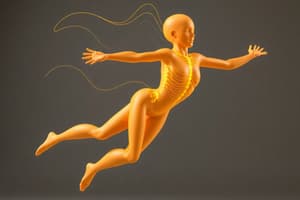Podcast
Questions and Answers
Which of the following describes stable movement patterns?
Which of the following describes stable movement patterns?
- Common with prior to changing patterns
- Greater variability in performance
- Always indicative of high skill level
- Less variability in performance (correct)
Unstable movement patterns are often associated with new tasks or changes in established patterns.
Unstable movement patterns are often associated with new tasks or changes in established patterns.
True (A)
Who created the Rood approach?
Who created the Rood approach?
Margaret Rood
The term _____ refers to the state of stiffness or tension in muscles.
The term _____ refers to the state of stiffness or tension in muscles.
Match the following terms with their descriptions:
Match the following terms with their descriptions:
Which theory explains that reflexes are combined to produce complex behavior?
Which theory explains that reflexes are combined to produce complex behavior?
According to the systems theory, learning a simple movement pattern can help in controlling more degrees of freedom (df).
According to the systems theory, learning a simple movement pattern can help in controlling more degrees of freedom (df).
What do central pattern generators control in the motor programming theory?
What do central pattern generators control in the motor programming theory?
The ___ theory suggests that higher cognitive centers control lower centers of the CNS.
The ___ theory suggests that higher cognitive centers control lower centers of the CNS.
What limitation is associated with reflex theory?
What limitation is associated with reflex theory?
Match the following theories with their key concept:
Match the following theories with their key concept:
Which statement about motor programming theories is true?
Which statement about motor programming theories is true?
In hierarchical theory, it is believed that lower levels have no influence over higher cognitive levels.
In hierarchical theory, it is believed that lower levels have no influence over higher cognitive levels.
Classical conditioning involves learning through trial and error.
Classical conditioning involves learning through trial and error.
Which type of learning relies on higher cortical processes such as awareness and attention?
Which type of learning relies on higher cortical processes such as awareness and attention?
What is the term for learning automatic tasks that are not dependent on awareness?
What is the term for learning automatic tasks that are not dependent on awareness?
In Adam's closed loop theory, sensory feedback is necessary to learn skilled __________.
In Adam's closed loop theory, sensory feedback is necessary to learn skilled __________.
Match the following learning theories with their key concepts:
Match the following learning theories with their key concepts:
What does Schmidt's schema theory imply about variability in learning environments?
What does Schmidt's schema theory imply about variability in learning environments?
What is the role of an 'error signal' in Schmidt’s schema theory?
What is the role of an 'error signal' in Schmidt’s schema theory?
Procedural learning can be consciously recalled and articulated.
Procedural learning can be consciously recalled and articulated.
Which type of synergy is more commonly observed?
Which type of synergy is more commonly observed?
Inhibiting abnormal patterns is a primary focus of Bobath's neurodevelopmental treatment (NDT).
Inhibiting abnormal patterns is a primary focus of Bobath's neurodevelopmental treatment (NDT).
What is the primary benefit of proprioceptive neuromuscular facilitation (PNF)?
What is the primary benefit of proprioceptive neuromuscular facilitation (PNF)?
In the process of motor learning, ____ is defined as temporary changes, while ____ represents permanent changes.
In the process of motor learning, ____ is defined as temporary changes, while ____ represents permanent changes.
Match the following concepts with their descriptions:
Match the following concepts with their descriptions:
What is a characteristic of the task-oriented approach in motor learning?
What is a characteristic of the task-oriented approach in motor learning?
Frequent stimulation and motor repetition are not essential for retaining learned motor abilities.
Frequent stimulation and motor repetition are not essential for retaining learned motor abilities.
Which stage of motor learning focuses on understanding the movement and is more cognitive in nature?
Which stage of motor learning focuses on understanding the movement and is more cognitive in nature?
What are the two main types of motor learning mentioned?
What are the two main types of motor learning mentioned?
Practice of parts of a task is more beneficial than practice of the whole task for all types of skills.
Practice of parts of a task is more beneficial than practice of the whole task for all types of skills.
What is the primary focus of task-specific training?
What is the primary focus of task-specific training?
Intrinsic feedback is optimal for promoting _____ and generalization.
Intrinsic feedback is optimal for promoting _____ and generalization.
Match the following stages of motor learning with their key characteristics:
Match the following stages of motor learning with their key characteristics:
Which principle states that learning requires solving the motor problem rather than rote repetition?
Which principle states that learning requires solving the motor problem rather than rote repetition?
High levels of motivation and engagement do not influence the learning process.
High levels of motivation and engagement do not influence the learning process.
What is the optimal condition for variability in practice during motor learning?
What is the optimal condition for variability in practice during motor learning?
Flashcards are hidden until you start studying
Study Notes
Reflex Theory
- Complex behaviors are formed by chaining individual reflex actions.
- Limitations include spontaneous movements that do not require stimuli, movements occurring faster than the stimulus, and variability of responses from a single stimulus.
- Novel movements are not accounted for in this theory.
Hierarchical Theory
- Higher cognitive centers oversee lower centers in motor control.
- Motor development in children correlates with increased corticalization in the CNS.
- Current concepts challenge the "top-down" control notion, suggesting lower levels can influence higher centers.
Motor Programming Theories
- Movement patterns can be triggered by sensory stimuli or through central processes.
- Central pattern generators are hardwired neural circuits responsible for specific movements, demonstrated in spinal walking studies with cats.
- Emphasis on retraining functional movements rather than isolating movements.
Systems Theory
- Considers the whole body, gravity, and inertia in motor control, not just the CNS.
- Highlights multiple degrees of freedom (df) in the body, advocating teaching simple movements before complex ones.
- Stability in movement patterns is linked to less variability, while unstable patterns show greater variability during skill acquisition.
Ecological Theory
- Movement is goal-oriented, with perceptions guiding behavior influenced by the environment.
- Encourages exploration of various methods to complete a task.
Integrated Theory of Motor Control
- Incorporates different treatment approaches and advocates for the rediscovery of normal movement patterns.
Rood Approach
- Developed by Margaret Rood, combining occupational and physical therapy principles.
- Differentiates between heavy work (stabilization) and light work (movement).
- Utilizes sensory stimuli for motor response elicitation and begins treatment at the patient's developmental level.
Brunnstrom’s Movement Therapy
- Designed for hemiplegia recovery post-cerebrovascular accident.
- Focuses on recovery through stereotypical limb movement patterns or synergies.
- Involves levels of recovery progressing from flaccid state to voluntary movements.
Proprioceptive Neuromuscular Facilitation (PNF)
- A technique aimed at enhancing neuromuscular response using proprioceptive stimulation and diagonal movements.
- Balance among antagonist muscles is key, with repeated movements aiding motor retention.
Bobath’s Neurodevelopmental Treatment (NDT)
- Focuses on sensory awareness of movement for hemiplegic patients.
- Involves basic postural movements to inhibit abnormal patterns and stimulate normal ones.
Motor Learning & Task-Oriented Approach
- Incorporates functional tasks into neuro-facilitation methods.
- Motor learning encompasses problem-solving skills and adaptability to environmental changes.
Types of Motor Learning
- Implicit learning occurs unconsciously, while explicit learning requires awareness and reflection.
- Learning can be procedural (automatic) or declarative (conscious).
Motor Learning Theories
- Adam's Closed Loop Theory stresses sensory feedback in skill acquisition but has limitations with novel movements.
- Schmidt’s Schema Theory uses generalized motor programs to select and evaluate responses but falls short on immediate learning of new movements.
- Ecological theory prioritizes finding optimal motor strategies and matching them to perceptual cues during task performance.
Stages of Motor Learning
- Stage 1: Acquisition - cognitive understanding with decreased variability.
- Stage 2: Skill Refinement - associative learning for movement refinement.
- Stage 3: Skill Retention - autonomous performance with expert execution.
Task-Specific Training
- Defined as active, repetitive practice of functional activities for motor skill learning or relearning.
- Emphasizes the importance of feedback, intrinsic motivation, and variable practice for optimal learning and generalization.
Studying That Suits You
Use AI to generate personalized quizzes and flashcards to suit your learning preferences.




